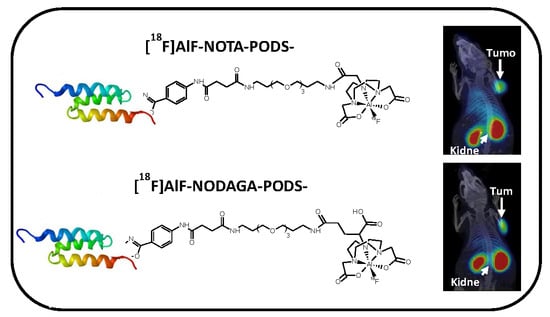Thiol-Reactive PODS-Bearing Bifunctional Chelators for the Development of EGFR-Targeting [18F]AlF-Affibody Conjugates
Abstract
1. Introduction
2. Results and Discussion
2.1. Preparation of Bifunctional Chelators NOTA-PODS and NODAGA-PODS
2.2. Preparation of NOTA-PODS-ZEGFR:03115 and NODAGA-PODS-ZEGFR:03115
2.3. [18F]AlF Radiolabeling and In Vitro Stability
2.4. In Vivo Studies
3. Materials and Methods
3.1. General Materials and Methods
3.2. Preparation of NOTA-PODS and NODAGA-PODS
3.3. Preparation of NOTA-PODS-ZEGFR:03115 and NODA-PODS-ZEGFR:03115
3.4. Radiosynthesis of [18F]AlF-NOTA-PODS-ZEGFR:03115 and [18F]AlF-NODAGA-PODS-ZEGFR:03115
3.5. Determination of Distribution Coefficient (LogD) at pH 7.4
3.6. In Vitro Serum Stability Assay
3.7. In Vivo Evaluation
4. Conclusions
Supplementary Materials
Author Contributions
Funding
Acknowledgments
Conflicts of Interest
References
- Gunnoo, S.B.; Madder, A. Chemical protein modification through cysteine. ChemBioChem 2016, 17, 529–553. [Google Scholar] [CrossRef]
- Koniev, O.; Wagner, A. Developments and recent advancements in the field of endogenous amino acid selective bond forming reactions for bioconjugation. Chem. Soc. Rev. 2015, 44, 5495–5551. [Google Scholar] [CrossRef] [PubMed]
- Ravasco, J.M.J.M.; Faustino, H.; Trindade, A.; Gois, P.M.P. Bioconjugation with maleimides: A useful tool for chemical biology. Chem. Eur. J. 2019, 25, 43–59. [Google Scholar] [CrossRef] [PubMed]
- Sabot, C.; Renard, P.-Y.; Renault, K.; Fredy, J.W. Covalent modification of biomolecules through maleimide-based labeling strategies. Bioconjugate Chem. 2018, 29, 2497–2513. [Google Scholar]
- Alley, S.C.; Benjamin, D.R.; Jeffrey, S.C.; Okeley, N.M.; Meyer, D.L.; Sanderson, R.J.; Senter, P.D. Contribution of linker stability to the activities of anticancer immunoconjugates. Bioconjugate Chem. 2008, 19, 759–765. [Google Scholar] [CrossRef] [PubMed]
- Baldwin, A.D.; Kiick, K.L. Tunable degradation of maleimide–thiol adducts in reducing environments. Bioconjugate Chem. 2011, 22, 1946–1953. [Google Scholar] [CrossRef] [PubMed]
- Ponte, J.F.; Sun, X.; Yoder, N.C.; Fishkin, N.; Laleau, R.; Coccia, J.; Lanieri, L.; Bogalhas, M.; Wang, L.; Wilhelm, S.; et al. Understanding how the stability of the thiol-maleimide linkage impacts the pharmacokinetics of lysine-linked antibody-maytansinoid conjugates. Bioconjugate Chem. 2016, 27, 1588–1598. [Google Scholar] [CrossRef]
- Szijj, P.A.; Bahou, C.; Chudasama, V. Minireview: Addressing the retro-Michael instability of maleimide bioconjugates. Drug Discov. Today Technol. 2018, 30, 27–34. [Google Scholar] [CrossRef]
- Bernardim, B.; Cal, P.M.S.D.; Matos, M.J.; Oliveira, B.L.; Martínez-Sáez, N.; AlbuquerqueInês, S.; Perkins, E.; Corzana, F.; Burtoloso, A.C.B.; Jiménez-Osés, G.; et al. Stoichiometric and irreversible cysteine-selective protein modification using carbonylacrylic reagents. Nat. Commun. 2016, 7, 13128–13137. [Google Scholar] [CrossRef]
- Kalia, D.; Malekar, P.V.; Parthasarathy, M. Exocyclic olefinic maleimides: Synthesis and application for stable and thiol-selective bioconjugation. Angew. Chem. Int. Ed. Engl. 2016, 55, 1432–1435. [Google Scholar] [CrossRef]
- Toda, N.; Asano, S.; Barbas, C.F.I. Rapid, stable, chemoselective labeling of thiols with Julia-Kocieński-like reagents: A serum-stable alternative to maleimide-based protein conjugation. Angew. Chem. Int. Ed. Engl. 2013, 52, 12592–12596. [Google Scholar] [CrossRef] [PubMed]
- Patterson, J.T.; Asano, S.; Li, X.; Rader, C.; Barbas, C.F.I. Improving the serum stability of site-specific antibody conjugates with sulfone linkers. Bioconjugate Chem. 2014, 25, 1402–1407. [Google Scholar] [CrossRef] [PubMed]
- Zhang, Q.; Dall’Angelo, S.; Fleming, I.N.; Schweiger, L.F.; Zanda, M.; O’Hagan, D. Last-step enzymatic [18F]-fluorination of cysteine-tethered RGD peptides using modified Barbas linkers. Chem. Eur. J. 2016, 22, 10998–11004. [Google Scholar] [CrossRef] [PubMed]
- Chiotellis, A.; Sladojevich, F.; Mu, L.; Müller Herde, A.; Valverde, I.E.; Tolmachev, V.; Schibli, R.; Ametamey, S.M.; Mindt, T.L. Novel chemoselective 18F-radiolabeling of thiol-containing biomolecules under mild aqueous conditions. Chem. Commun. 2016, 52, 6083–6086. [Google Scholar] [CrossRef] [PubMed]
- Adumeau, P.; Davydova, M.; Zeglis, B.M. Thiol-reactive bifunctional chelators for the creation of site-selectively modified radioimmunoconjugates with improved stability. Bioconjug. Chem. 2018, 29, 1364–1372. [Google Scholar] [CrossRef]
- McBride, W.J.; Sharkey, R.M.; Karacay, H.; D’Souza, C.A.; Rossi, E.A.; Laverman, P.; Chang, C.H.; Boerman, O.C.; Goldenberg, D.M. A novel method of 18F radiolabeling for PET. J. Nucl. Med. 2009, 50, 991–998. [Google Scholar] [CrossRef]
- Da Pieve, C.; Allott, L.; Martins, C.D.; Vardon, A.; Ciobota, D.M.; Kramer-Marek, G.; Smith, G. Efficient [18F]AlF radiolabeling of ZHER3:8698 affibody molecule for imaging of HER3 positive tumors. Bioconjug. Chem. 2016, 27, 1839–1849. [Google Scholar] [CrossRef]
- Kim, Y.; Ho, S.O.; Gassman, N.R.; Korlann, Y.; Landorf, E.V.; Collart, F.R.; Weiss, S. Efficient site-specific labeling of proteins via cysteines. Bioconjug. Chem. 2008, 19, 786–791. [Google Scholar] [CrossRef]
- Liu, Y.; Hu, X.; Liu, H.; Bu, L.; Ma, X.; Cheng, K.; Li, J.; Tian, M.; Zhang, H.; Cheng, Z. A comparative study of radiolabeled bombesin analogs for the PET imaging of prostate cancer. J. Nucl. Med. 2013, 54, 2132–2138. [Google Scholar] [CrossRef]
- D’Souza, C.A.; McBride, W.J.; Sharkey, R.M.; Todaro, L.J.; Goldenberg, D.M. High-yielding aqueous 18F-labeling of peptides via Al18F chelation. Bioconjug. Chem. 2011, 22, 1793–1803. [Google Scholar] [CrossRef]
- Löfblom, J.; Feldwisch, J.; Tolmachev, V.; Carlsson, J.; Ståhl, S.; Frejd, F.Y. Affibody molecules: Engineered proteins for therapeutic, diagnostic and biotechnological applications. Febs Lett. 2010, 584, 2670–2680. [Google Scholar] [CrossRef] [PubMed]
- Burley, T.A.; Da Pieve, C.; Martins, C.D.; Ciobota, D.M.; Allott, L.; Oyen, W.J.G.; Harrington, K.J.; Smith, G.; Kramer-Marek, G. Affibody-Based PET Imaging to Guide EGFR-Targeted Cancer Therapy in Head and Neck Squamous Cell Cancer Models. J. Nucl. Med. 2019, 60, 353–361. [Google Scholar] [CrossRef] [PubMed]
- Behr, T.M.; Goldenberg, D.M.; Becker, W. Reducing the renal uptake of radiolabeled antibody fragments and peptides for diagnosis and therapy: Present status, future prospects and limitations. Eur. J. Nucl. Med. 1998, 25, 201–212. [Google Scholar] [CrossRef]
- Su, X.; Cheng, K.; Jeon, J.; Shen, B.; Venturin, G.T.; Hu, X.; Rao, J.; Chin, F.T.; Wu, H.; Cheng, Z. Comparison of two site-specifically 18F-labeled affibodies for PET imaging of EGFR positive tumors. Mol. Pharm. 2014, 11, 3947–3956. [Google Scholar] [CrossRef] [PubMed]
- Workman, P.; Aboagye, E.O.; Balkwill, F.; Balmain, A.; Bruder, G.; Chaplin, D.J.; Double, J.A.; Everitt, J.; Farningham, D.A.H.; Glennie, M.J.; et al. Guidelines for the welfare and use of animals in cancer research. Br. J. Cancer 2010, 102, 1555–1577. [Google Scholar] [CrossRef]
- Martins, C.D.; Da Pieve, C.; Burley, T.A.; Smith, R.; Ciobota, D.M.; Allott, L.; Harrington, K.J.; Oyen, W.J.G.; Smith, G.; Kramer-Marek, G. HER3-mediated resistance to Hsp90 inhibition detected in breast cancer xenografts by affibody-based PET imaging. Clin. Cancer Res. 2018, 24, 1853–1865. [Google Scholar] [CrossRef]
Sample Availability: Samples of the compounds are not available. |
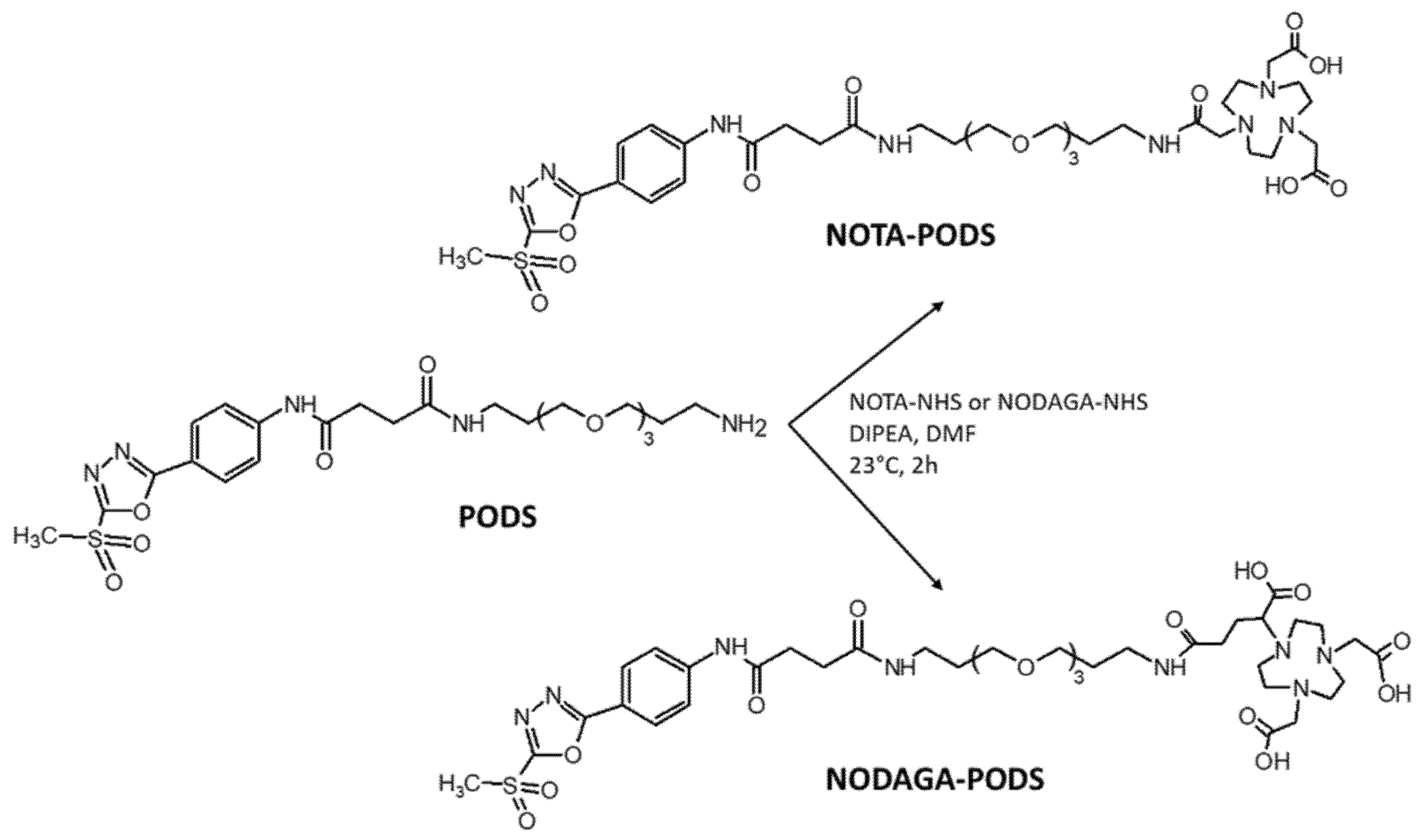
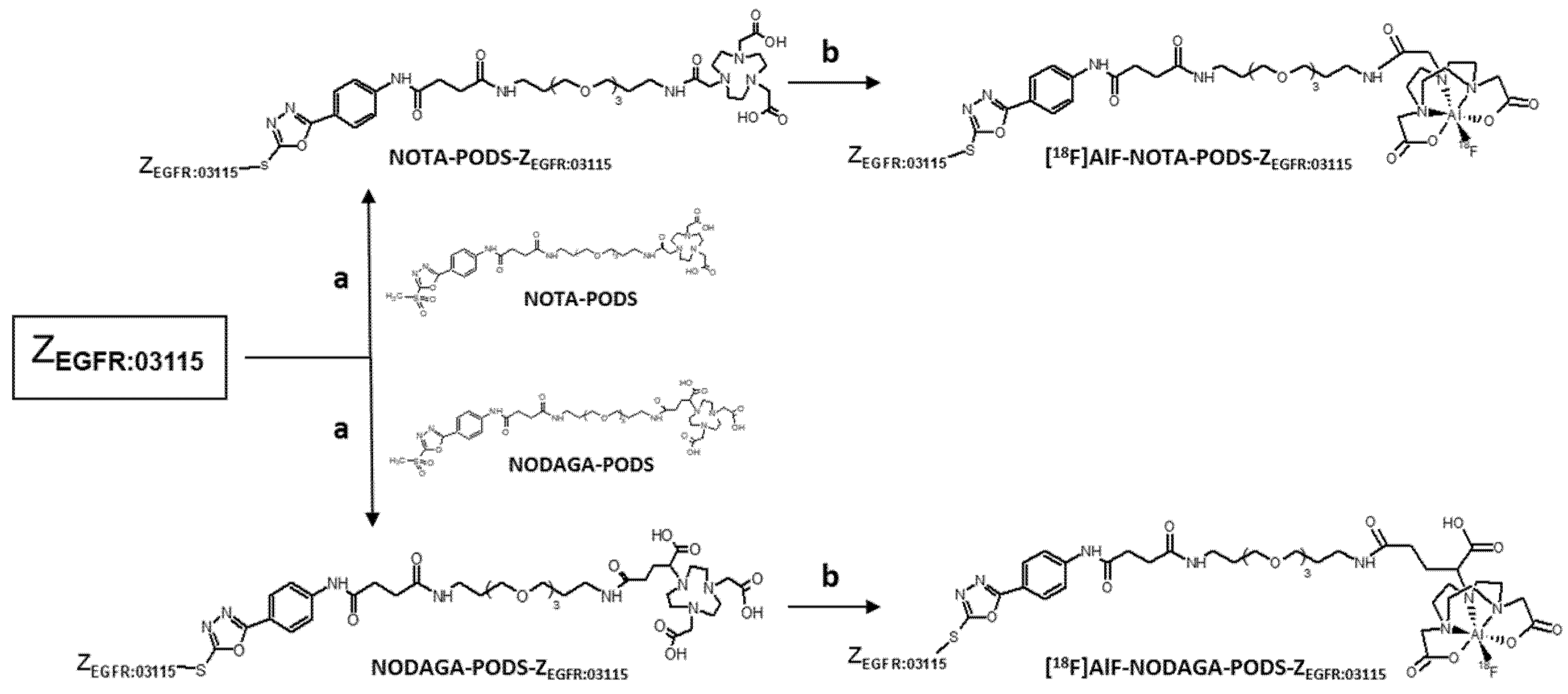

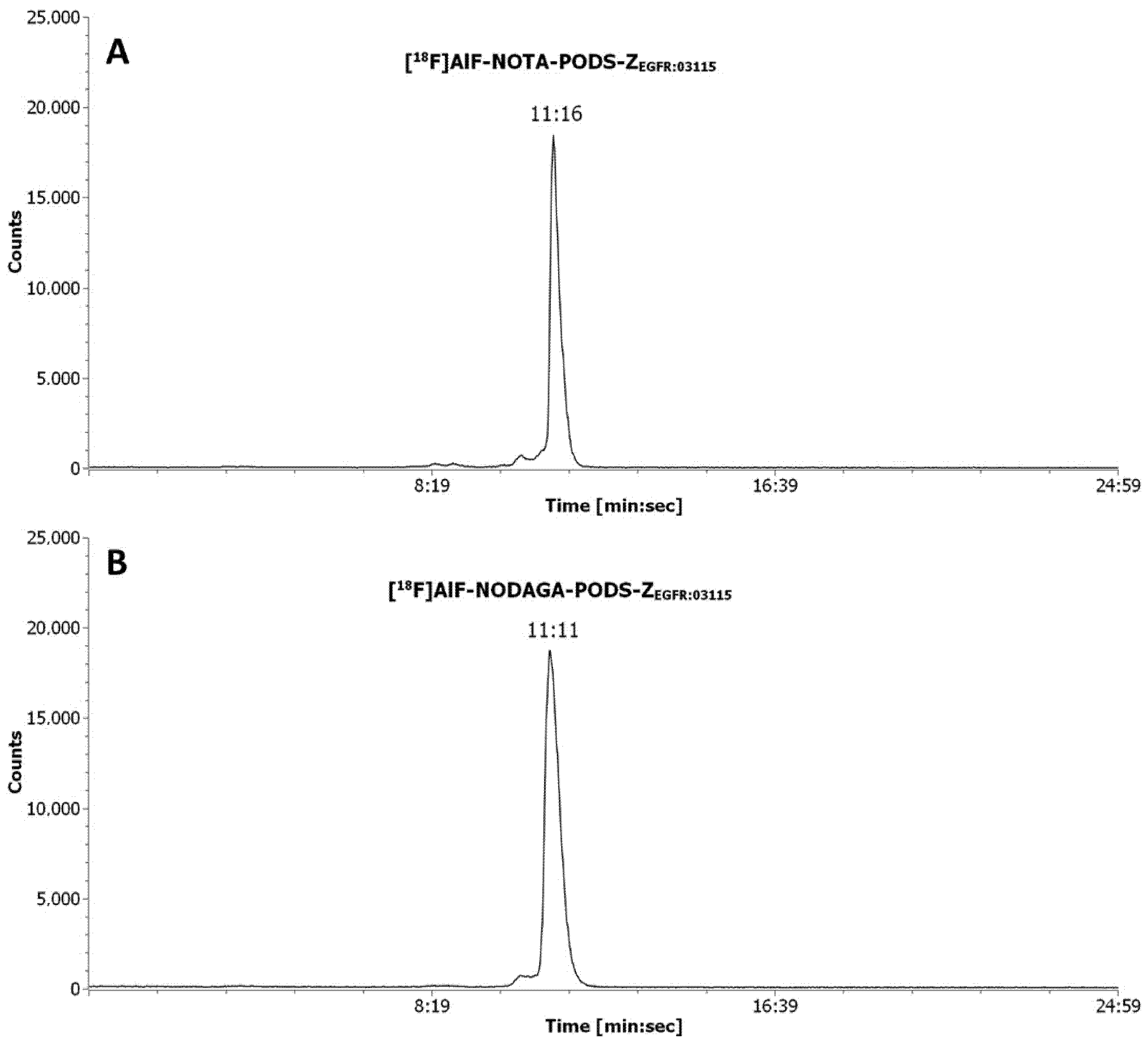
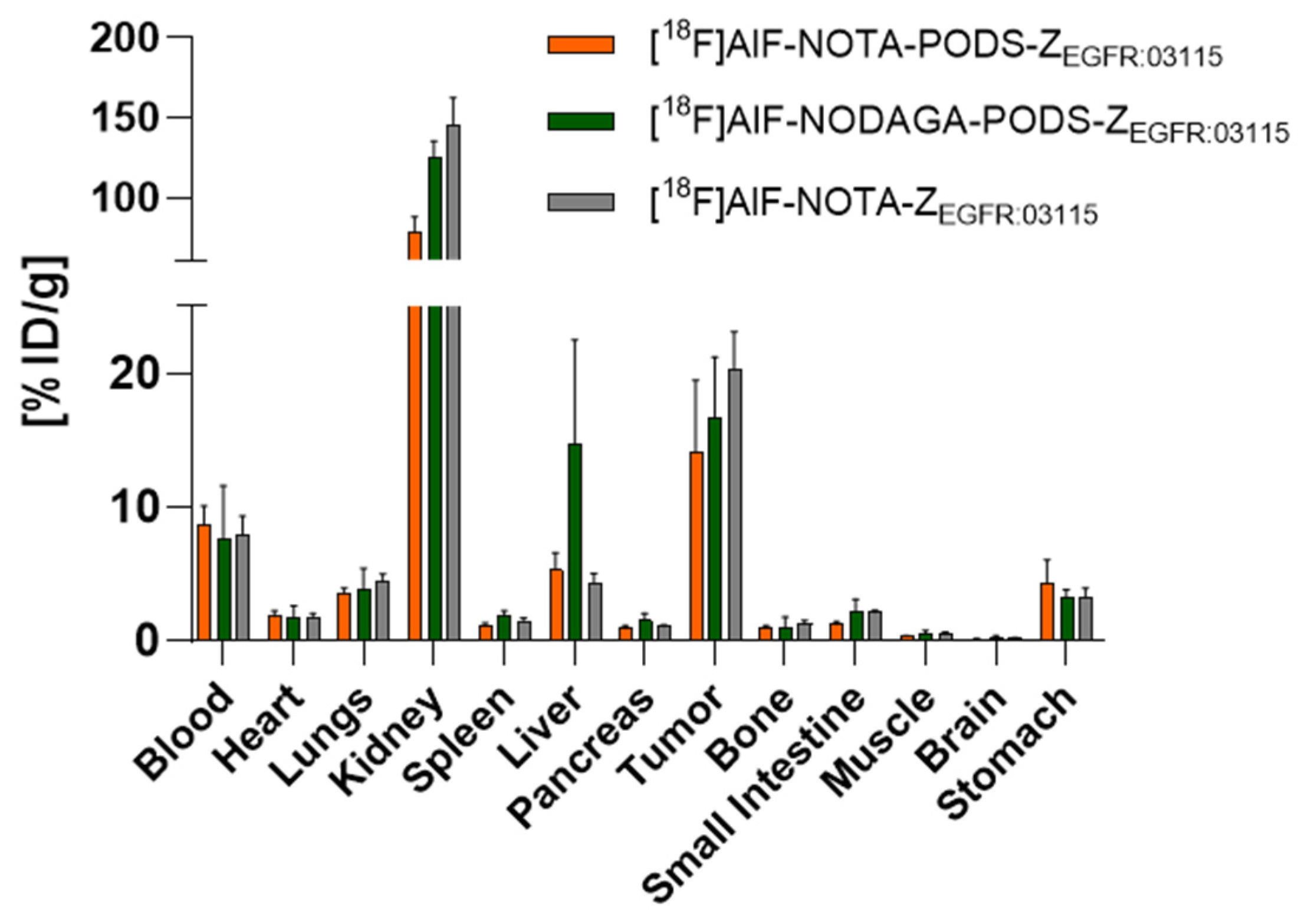
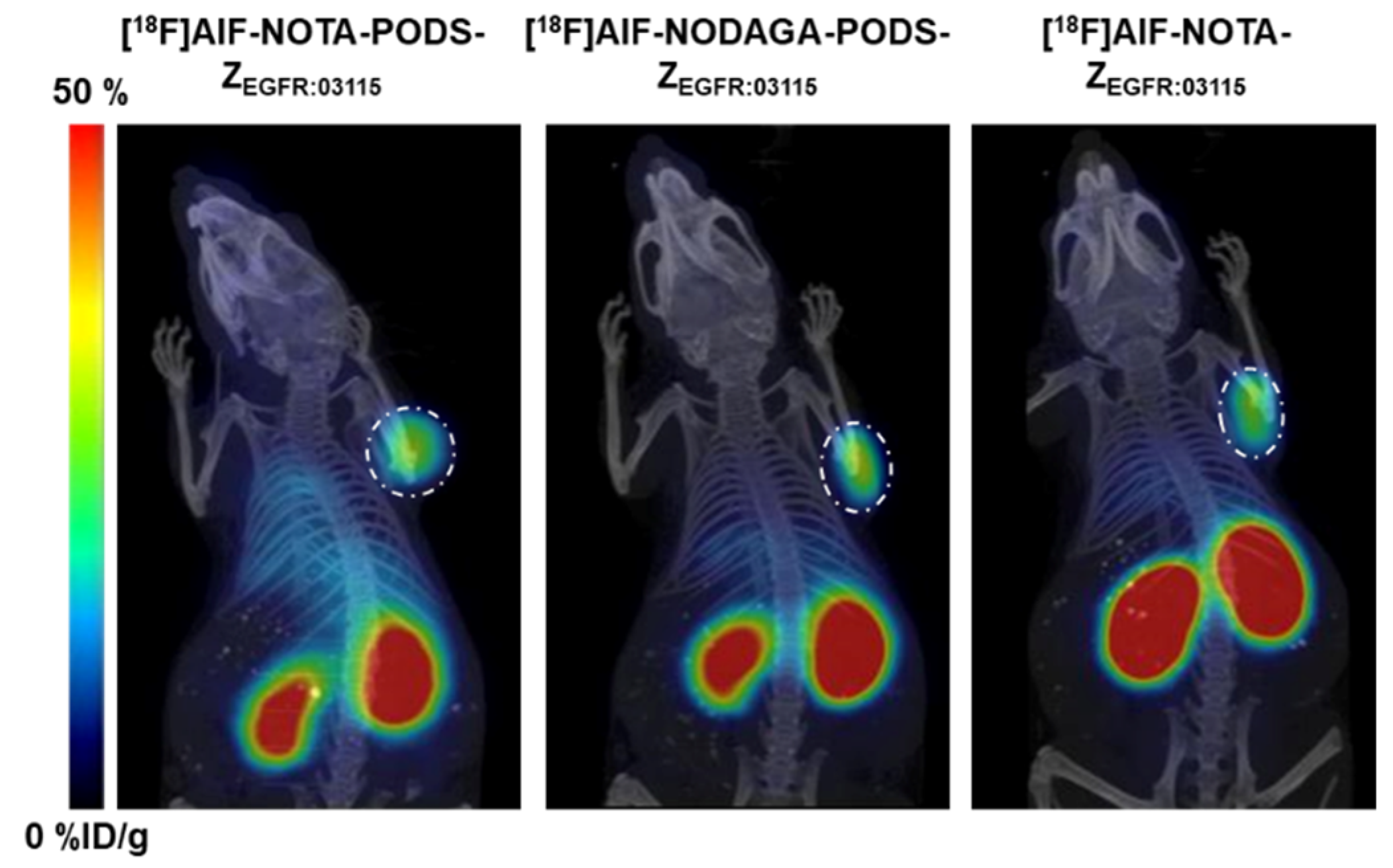
| Radioconjugate | RCY | SA/MA | Protein Recovery |
|---|---|---|---|
| [18F]AIF-NOTA-PODS-ZEGFR:03115 | 11.0%–12.7% | 0.40–0.59 MBq/μg 3.0–4.4 MBq/nmol | 37.1%–38.0% |
| [18F]AIF-NODAGA-PODS-ZEGFR:03115 | 4.3%–8.1% | 0.11–0.23 MBq/μg 0.8–1.7 MBq/nmol | 23.9%–26.0% |
| [18F]AIF-NOTA-ZEGFR:03115 | 10.7%–38.0% | 0.57–1.09 MBq/μg 4.1–7.8 MBq/nmol | 10.6%–34.5% |
| Tumor-to-Organ Ratio | ||||
|---|---|---|---|---|
| Blood | Kidney | Liver | Muscle | |
| [18F]AIF-NOTA-PODS-ZEGFR:03115 | 1.6 ± 0.6 | 0.2 ± 0.1 | 2.7 ± 1.2 | 37.2 ± 12.4 |
| [18F]AIF-NODAGA-PODS-ZEGFR:03115 | 2.6 ± 1.2 | 0.1 ± 0.0 | 1.3 ± 0.6 | 31.3 ± 8.2 |
| [18F]AIF-NOTA-ZEGFR:03115 | 2.8 ± 0.9 | 0.1 ± 0.0 | 4.7 ± 0.8 | 34.9 ± 3.4 |
© 2020 by the authors. Licensee MDPI, Basel, Switzerland. This article is an open access article distributed under the terms and conditions of the Creative Commons Attribution (CC BY) license (http://creativecommons.org/licenses/by/4.0/).
Share and Cite
Da Pieve, C.; Makarem, A.; Turnock, S.; Maczynska, J.; Smith, G.; Kramer-Marek, G. Thiol-Reactive PODS-Bearing Bifunctional Chelators for the Development of EGFR-Targeting [18F]AlF-Affibody Conjugates. Molecules 2020, 25, 1562. https://doi.org/10.3390/molecules25071562
Da Pieve C, Makarem A, Turnock S, Maczynska J, Smith G, Kramer-Marek G. Thiol-Reactive PODS-Bearing Bifunctional Chelators for the Development of EGFR-Targeting [18F]AlF-Affibody Conjugates. Molecules. 2020; 25(7):1562. https://doi.org/10.3390/molecules25071562
Chicago/Turabian StyleDa Pieve, Chiara, Ata Makarem, Stephen Turnock, Justyna Maczynska, Graham Smith, and Gabriela Kramer-Marek. 2020. "Thiol-Reactive PODS-Bearing Bifunctional Chelators for the Development of EGFR-Targeting [18F]AlF-Affibody Conjugates" Molecules 25, no. 7: 1562. https://doi.org/10.3390/molecules25071562
APA StyleDa Pieve, C., Makarem, A., Turnock, S., Maczynska, J., Smith, G., & Kramer-Marek, G. (2020). Thiol-Reactive PODS-Bearing Bifunctional Chelators for the Development of EGFR-Targeting [18F]AlF-Affibody Conjugates. Molecules, 25(7), 1562. https://doi.org/10.3390/molecules25071562






